Or – “And Not Always For The Better…”
Every medium has watershed moments; stories, characters or events that change the paradigm for all art of that type. Going back to the days when movie careers were ruined by “Talkies” (look up Gloria Swanson sometime) these shifts can be jarring for everyone involved, from the creators to the fictional characters themselves. A sea change is always invigorating, but there’s not way to control or to predict where such reimaginings will actually take us…
Days Of Future Past (X-Men, Marvel Comics – 1981)
This one is kind of a tease, in that it’s our next trade-paperback review on the MSP, and so I’m going to keep the bulk of my comments to myself. But this tale is incredibly important (arguably more than the Death of Phoenix) to the current state of the X-Universe, and the endless event mentality that one has to tolerate to read an X-Title. Given that we have THREE SEPARATE AND DISTINCT CHARACTERS who joined the X-Men as time-travelers from variations on this reality, we couldn’t have this discussion without touching on it. (I’ll tell you who and why this may or may not be a good thing on next weeks Major Spoilers Podcast!)
Watchmen (DC Comics – 1986)
Comparing Watchmen to other books of the time period is really a case of comparing sexy apples and angry oranges: There’s little to no possible comparison. A deeply personal title for the creators, filled with extensive character work that had never before been seen in comics, these twelve issues took comic storytelling to a whole new level. They also instilled in writers a need to use visual metaphor (many times extremely crudely), a belief that you had to have apocalyptic events and grim circumstances for a book to matter, and a tendency for every superhero to have real-world personality disorders, kinks, and foibles. Sometimes it worked very well (Denny O’Neil’s redefining take on Vic Sage, The Question) and other times it completely destroyed the character (Jason Todd, anyone?)
Mirror, Mirror (Star Trek: The Original Series – 1967)
Alternate universes and evil twins have been staples of fiction (especially escapist fiction) since Hector was a pup, and many a tale has been woven around mistaken identities and inverted character expectations. But when Gene Roddenberry and his creative staff assembled this alternate universe tale of the Imperial Starship Enterprise and it’s ruthless, evil Captain, they created a new hybrid of existing tropes. The problem comes, of course, with suspension of disbelief. In a world where anyone who wants a promotion kills the man ahead of them and takes his job, it’s highly unlikely that the entire crew of Kirk’s Enterprise would have ever actually assembled, much less been in the exact same formation as in our world, and additional voyages into that universe made for darker and more adult tales, but also went further and further out to differentiate characters from their real-world counterparts. (Alternate Kira Nerys in her milkbath is but one example…) Worse still, the shock value of a dark mirror is lessened each time you look into it, and this trope’s appearance in an episode of South Park should be a sign that we need a new alternate universe paradigm.
The Death of Gwen Stacy (Spider-Man, Marvel Comics – 1973)
Certainly not the first death in comics, nor the first time a character was taken out for dramatic effect (The Comet bought it back in the 40’s, spurring his brother to become the Hangman out of guilt and such) Gwen’s preciptious fall is one of the most iconic moments in Spider-Man’s storied history. The tiny, insignificant, almost invisible “Snap” makes it possible to read this sequence as Spider-Man CAUSING her death, and the resonance of this event made Spider-Man a deeper and more nuanced character. It also led, eventually, to the spectacle of poor Alex stuffed in the fridge, Ice getting iced, and endlesss “girlfriend in jeopardy” plotlines (though, to be honest, those were pretty commonplace BEFORE this happened, as well.) Gwen’s status as sacrificial blonde was handled well, but the aftershocks of sexism that came from the “Snap Heard Around The L5 Vertebrae” are still bitterly argued 45 years later.
The Death Of Superman (DC Comics – 1993)
The most interesting part of the whole “Death of Superman” event for me is the fact that it was initially proposed (if you believe the stories) as a joke, something to vamp for time until the planned wedding of Clark and Lois. The battle between the Justice League and Doomsday, leaving only Superman standing is still problematic for me (you have to believe that the Man of Steel could only come up with “mindless slugfest” as a strategem for taking out Double-D) but the fallout from issue #75 was a worldwide phenomenon. Heroes had died before, and would die again, but this was truly the point where death took on both a new meaning and a complete lack of consequences. When Kal-El rose from the grave, with the only real consequence being a new haircut, it was clear that in the new era of comic storytelling, all bets were off and NOTHING was guaranteed to be permanent.
Flash Of Two Worlds (DC Comics – 1961)
I always liked when comic books reference OTHER comic books, and am saddened that it doesn’t happen very often any more. Barry Allen chose his new heroic motif and name as a fan of Jay Garrick’s comic adventures (serialized on his Earth-One by writers in touch with the cosmic squish principle) and when the two met, it was a watershed event in comic book history. First Jay, then the JSA, then their villains began appearing, and a yearly crossover became tradition. From this story came Earth-S (where the Fawcett heroes lived), Earth-X (where the Quality heroes lived), Earth-3 (where heroes were evil, bad is good, down with government, MILKSHAKE BOOM! ) and myriad other Earths until DC was forced to streamline their entire continuity in 1986. 52 returned those worlds to existence, but it’s telling that the new alternate Earths have currently gone by the wayside somewhat, as they’re even MORE complicated than the initial incarnations. And it all started with Barry Allen in a disused theatre in Central City, right here…
Secret Wars (Marvel Comics – 1984)
The universe-spanning giant crossover madness is a fact of life in today’s comic book market (Image is currently doing it, Marvel and DC just finished up with two, and the Wildstorm universe is in the midst of what I believe is the 23rd universal revamp in their 17 year publishing history) but there was a time when it was fresh and new. Secret Wars wasn’t the first of it’s kind (that’s probably Contest of Champions, a reworking of the aborted “Marvel Super-Heroes At The Olympics” super-special, torpedoed by those darn Commies) but it was the first to be fully commercialized, to the point where the licensing deals for toys and such made it forbidden that the book ever come out LATE. (If you ever wondered why the creative team changes for two issues in the middle, there’s your answer.) Jim Shooter took the characters who were most photogenic, toyetic and popular, and crafted a story that actually wasn’t half bad, if you don’t mind the illusion of change hiding the complete lack thereof. Now that everybody comes together to fight Thanos, Darkseid, The Time-Keeper and/or Al Simmons every six months without fail, it’s hard to remember that this book was a novelty, a game-changer, and one of the first times that the merchandizing of the book was more important than the content.
The Sound Of Her Wings (Sandman, Vertigo Comics – 1989)
The first seven issues of Sandman are a strange lot. I like to tell the story of my Sandman experience (bought issue #1, didn’t like it, came back four years later, bought and devoured all the trades) as indicative of how unusual these first books are compared to the rest of the story. Despite containing the wonderfully creepy and moody “24 Hours,” the first issues of Sandman could easily have been written for the Garrett Sanford incarnation that Kirby created in the 70’s. It isn’t until issue #8 that things truly show where this book was going, as we meet Morpheus/Dream’s big sister Death, and spend a day following her around in her duties as goth lolita Grim Reaper. (The scene with the baby chokes me up EVERY SINGLE TIME.) Dream’s metamorphosis from Robert-Smith-looking-cypher to Lord Of The Goddamn Dream really kicks off here, and brings the majority of what we now think of as “Vertigo storytelling” with it. Unfortunately, it also leads to half a dozen less interesting characters who are likewise disenfranchised gods and goddesses of stuff, and eventually turns into third-tier knockoffs of Choas Comics’ Lady Death…
The Judas Contract (New Teen Titans, DC Comics – 1984)
Sure, there had been characters with checkered pasts before, and team members who had turned traitor, but the Judas Contract told the story of a sweet little sixteen year old sociopathic murderer who joined the Teen Titans as a spy to turn them over to a villain and have them all butchered and their powers dissected. It’s pretty heady stuff, made even more awful by her perverse sexual relationship with a fifty-year-old Deathstroke and the devastating effect that her intentions had on the Teen Titans. Terra is one of the earliest incarnations of what I call the “Curse Of The Titans,” leading eventually to Wonder Girl’s widow status, Tempest’s death, Beast Boy and Raven’s bouts with madness, Cyborg’s transformation into monstrous machine man, as well as the endless deaths of secondary characters (Quick, name a former non-founding-Titan who isn’t dead, crazy or maimed!) and foreshadowed the darkness and endless dreary sturm und drang of 90’s “Grim & Gritty” comics. Her last freakout, wherein Terra inadvertantly (maybe) takes her own life, is still as powerful today as it was in 1984.
The Dark Knight Returns (DC Comics – 1986)
My dear friend Rebecca has a saying when someone finally references the elephant in the room: “And THERE it is.” Here we finally come to the center of the shrubbery maze, the book with which I have had a decades long love/hate relationship and which spawned damn near everything wrong with comics since the Reagan administration. None of that changes the fact that this is a tour de force of story and art, a wonderful world filled with sharply defined characters, and a Batman driven to the very edge of sanity. It’s most powerful moments are it’s most laughable (“Can’t armor my head!”) but even so, The Dark Knight is a wonderful tale of how Bruce Wayne overcomes all of the darkness in that horrible dystopian future to recapture hope, faith and his old batty self at the end. Of course, nobody remembers that part, all they remember is the monstrous Joker, the political satire, the neutered Superman and the now-dated TV panelist headshots. I truly believe that this comic is about as close as the form will ever get to explaining what a real superhero in our reality would be like, warts, ridicule and all, and it’s so close to BEING parody that you can’t even homage it without seeming a clear ripoff (Spider-Man: Reign, I’m looking at you.) For all it’s myriad strengths, though, this book, even more than Watchmen, presaged the eventual decline and near-collapse of the comic book industry and it’s transformation into quaint hobby only interesting to those who already know all the stories. (Hey, it’s better than “nerd herd morons who will probably snap and stab you,” which was a stereotype of comic books when I started reading them.) This is what Opus would call “a big ol’ gonzo bull-moose whopper of a mixed blessing,” cursing us to dozens of inferior knockoffs while inspiring other amazing works of art and eventually turning comics back away (sort of) from the grim, Dirty Harry heroes of the 80’s and early 90’s.
Faithful Spoilerite Question Of The Day: Are all turning points, by definition, mixed blessings? What do you think we’ll be saying about the return of Barry Allen or the resurgence of Green Lantern in a dozen years? And what stories did I miss?




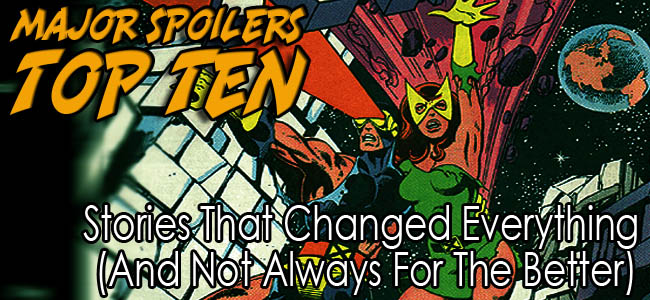
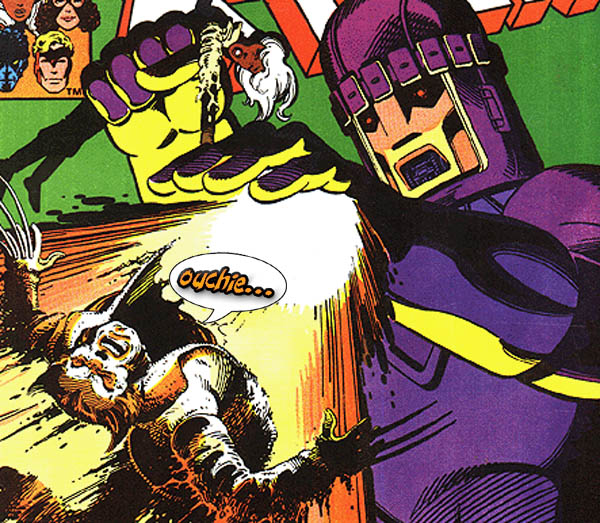
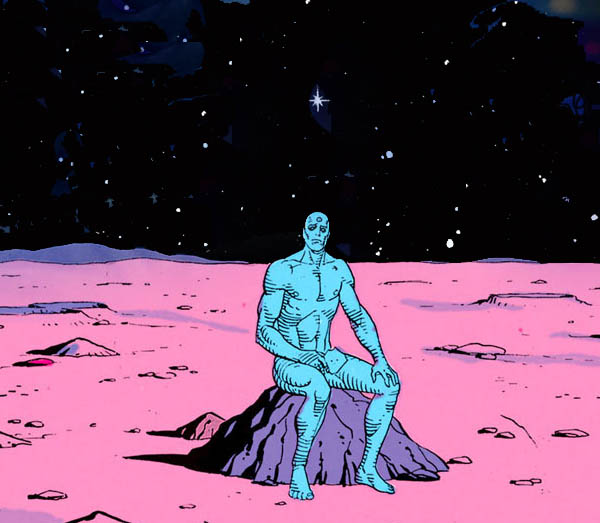
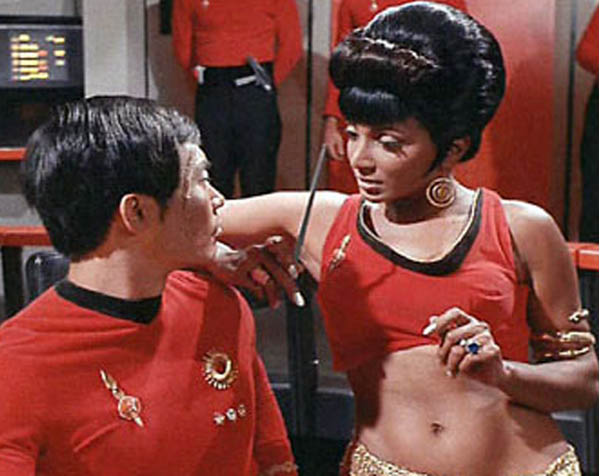
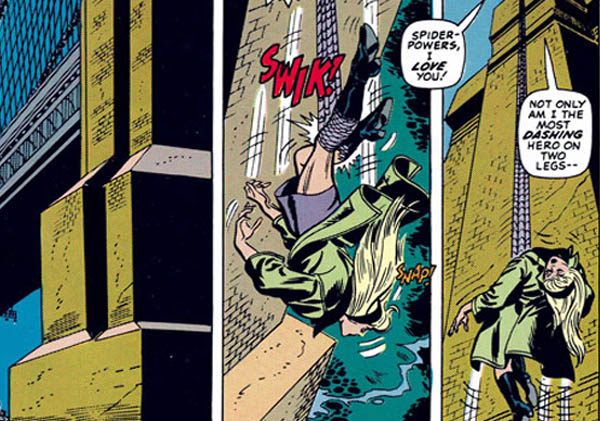
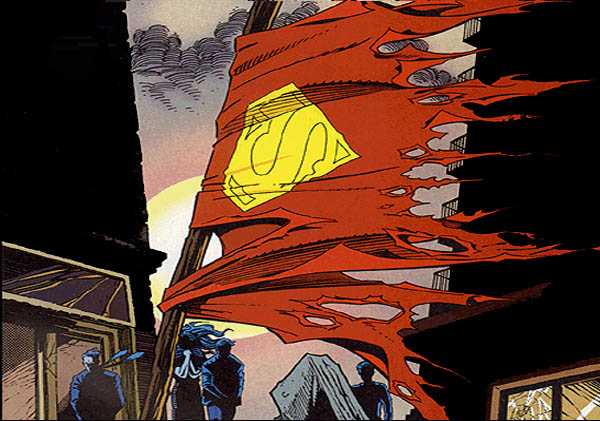
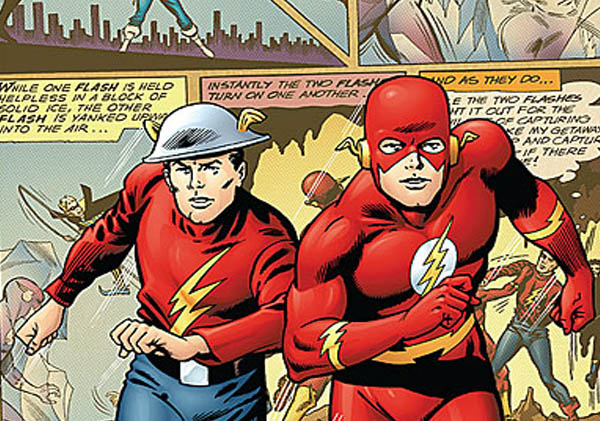

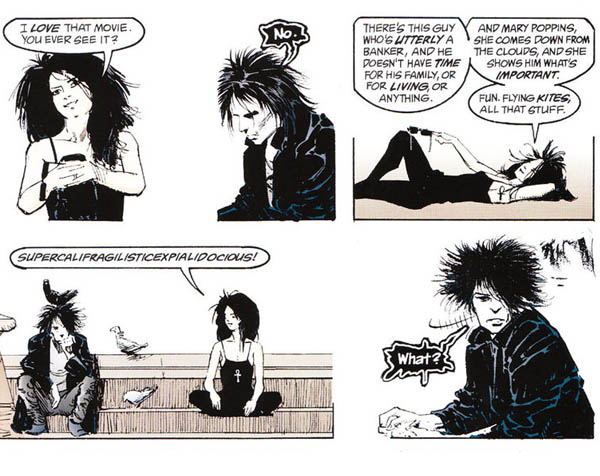
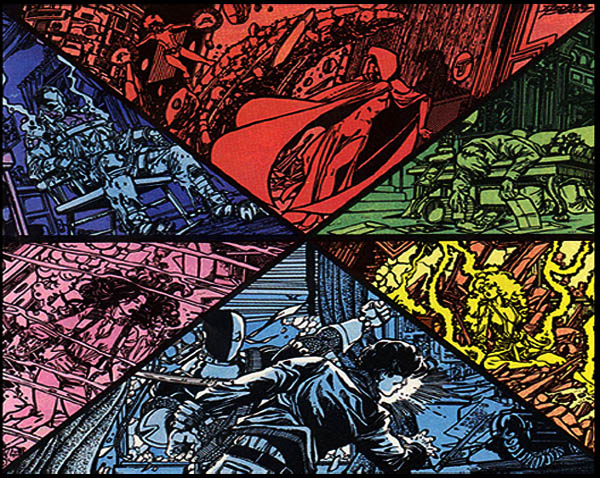

21 Comments
A very nice list.
I look forward to hearing the podcast on DoFP…I will simply say that my thoughts are what should have been a little more than a “What If?” story became the Marvel equivalent to original sin: hopelessly corrupting every great, almost-great, not-so-great, and throw-it-past-the-sewer-grate X-run since by requiring *every* creative X-team to do their own “dark future that intersects the uncertain now” story….and many of them more than once.
The insights on Batman:TDKR reflect my own thoughts, especially the part about how 99% of readers forget that the story ends with a wink and a smile.
If I could add one “honorable mention”: _Cerebus:_Church and State_. By this point, it was obvious that Dave Sim had a genuine phenomenon…but I don’t think *anyone* knew what it was. I refuse to admit that I think Cerebus was responsible for things other “furry” books, or wild-*ss-crazy letter columns, or trippy combinations of political farce/satire, or long-draw-out stories with no discernable end, or even comics featuring rapes…but *something* happened in those 50+ volumes that was a turning point not entirely for the better (at least not for Cerebus)
Great Top 10:
Dead Titans outnumber Titans alive something like 2 to 1.
“Crisis on Infinite Earths” didn’t make the cut? I thought it’s attempt to iron out all the conflicting origins/storylines was pretty huge.
P.S.- Hummm, I guess I should get around to read the Dark Knight Returns…
“Crisis on Infinite Earths” didn’t make the cut? I thought it’s attempt to iron out all the conflicting origins/storylines was pretty huge.
Umm,Crises on Infinite Earths was more of a game changer than Secret Wars.It changed the entire DC line up,whereas Secret War only introduced us to Venom and sold alot of toys.
Secret Wars and Crisis were both on the list, but I decided that, with the inclusion of “Flash of Two Worlds,” which STARTED the mess that Crisis had to clean up, Secret Wars was more evocative of the issues I wanted to talk about.
Mileage, as always, may vary.
I’m not saying you’re wrong, I just wanted to know why it wasn’t on the list seen how you’ve said in the past how this was one of the first “lets reboot everything!” sort of series.
Thanks for the clarification!
I think all turning points turn out to be mixed blessing with time if you look hard enough. Would X-Continuity be any more stable without Days of Future Past? I’m not so sure. I think the problem comes from egotistical writing and/or marketing wanting to squeeze more money out of a concept.
As for what you missed, what about Hank Pym’s spousal abuse?
I think maybe The Crow as a game changer, although I never loved it. Still, the impact it had not only on comics but on every day life for me at the time was pretty huge.
100 Bullets as another possibility because it moved the idea of “Vertigo books” away from just the weird/metaphysical worlds of Sandman and Preacher and Lucifer and showed that an incredibly violent, somewhere between noir and exploitation world was also possible in the world of comics.
Finally, Y the Last Man and Walking Dead for being so awesome they are absolutely game changing!
I think maybe The Crow as a game changer, although I never loved it. Still, the impact it had not only on comics but on every day life for me at the time was pretty huge.
Now, there’s a good one I hadn’t considered… In fact, I suspect that the Crow either influenced or came out of the same primordial idear soup that led to Sandman, Dawn and the whole “Incarnations of Emo” movement that came with them.
It’s truly sad that Major Spoilers Rule #5 clearly states that you are WRONG, SIR! WRONG! :)
So now for the Harry Mudd dilemma…you are absolutely right Matthew! (Tom Grice is wrong which means Matthew is wrong but Matthew is never wrong which means Tom Grice is right but Tom Grice is wrong so Matthew is wrong…Veeger! Veeger! Veeger!)
Non-maimed, non-dead, non-crazy Titan? Hmmm… does “The Protector” count? Either way, I bet he has been driven crazy by now with all the “medicinal marijuana” out there
Well Matthew, I don’t think you missed any… I could only come up with some “Honorable Mentions”:
The Uncanny X-men 256: Psylocke becomes a Super-Sexy-Ninja-Assassin… ugh. Did every character have to become a badass to survive the 90’s?
Daredevil #181: Even the main love-interests weren’t safe after this one…
G.I. Joe A Real American Hero: The first five episodes. Maybe the search for the 3 different fuels for the MASS DEVICE wasn’t the first time this happened, but it seems there were a ton of “We need to bring together the (random number) of rare (whatevers) to stop the enemy” type of stories after this aired…
The birth of Franklin Richards… Superheroes have sex? (shocking!) AND whenever a Super has children, they will be Super too! I’m actually surprised that this fact surprised Syndrome in the Incredibles; it has become a comic world certainty.
New Teen Titans #39: Robin and Kid Flash retire, eventually leading to a complete turn over of all the old sidekicks. After this, a sidekick could drive sales be having a different gender(ooooh… shocking!)or being killed by the Joker (with the help of a 900 number).
The Uncanny X-men #12: Cain Marko as the Juggernaut. “The bad guy is my long-lost stepbrother!” This even predates “Luke, I am your father”. Help us Matthew; did this start the whole bad-guy-as-family-member storytelling shortcut in comics?
Thanks for the fun list!
Umm,Crises on Infinite Earths was more of a game changer than Secret Wars.It changed the entire DC line up,whereas Secret War only introduced us to Venom and sold alot of toys.
Story-wise, you’re right – we’re still getting material out of Crisis, whereas Secret Wars really hasn’t had a lot of lasting effect. But it was the first “maxi-series” out of the gate and the first to drag as many of the regular line along with it for tie-ins as possible. So we can blame Secret Wars for a lot of the constant mire of events & crossovers simply by virtue of it being first. It might not be as lasting story-wise, but it definitely changed the industry, good or ill.
I would have put The Coming of Galactus here. The first fight between superheroes and ‘God’? I’d argue that the FF changed comics more than those stinky X-men and their silly moanin’.
The birth of Franklin Richards… Superheroes have sex? (shocking!) AND whenever a Super has children, they will be Super too! I’m actually surprised that this fact surprised Syndrome in the Incredibles; it has become a comic world certainty.
Reed and Sue have never had sex. This is why she has such a massive case of the screaming thigh-sweats for Namor. Reed, in his new gelatinous form, reproduced by mitosis using Susan as an incubator. (Which, now that I think of it, is awful, horrible, sexist, disgusting, and in the new comic paradigm, probably going to end up being true.)
Awesome, awesome list. Though I would have have added the creation of the JSA, Spideys debut and probably Animal Man by Grant Morrison.
As to Matthew’s question:
Yes, they are a mixed blessing. Such game-changing turning points are what make the classics ‘classic.’ The events, stories, and tropes that are originally singular and important quickly become mass-produced and almost necessarily less valuable.
For example, Days of Future Past was amazing because it showed that the actions of today have consequence for the future (even in comics!) which has now become meaningless with so many reiterations of the common themes showing without a doubt that this is a comic-book ruse or blatant lie. But it makes it no less great in its original manifestation.
I think I’d make an argument for Batman 428, “A Death in the Family”, which put the life of Robin – and the direction of comic books – squarely in the hands of the fans. That was the first time I can remember a storyline making its way into “USA Today” and the evening news; following that, the publishers were able to get newsprint out of Spiderman’s wedding, Superman’s death (even Lois learning his identity), the extinction of the Earth in Giffen’s Legion run… Changing the status quo became good for business, to the point that today, there is no status quo. (You’re welcome, Barry Allen.)
I’d also argue that the final decision of the fans, in favor of letting Robin die, gave the ultimate thumbs-up for the dark and gritty characters and stories that made up the next decade and beyond. When Robin dies, it’s because he’s not the window to the reader anymore; the readers were grown-up and ready for grown-up stories.
The kicker is, out of 10,000 votes, Robin’s fate was decided by less than a hundred. Years later, Denny O’Neill related in an interview that several hundred calls were traced to one number, and it was suspected that the person in question had rigged his computer to call the ‘KILL’ number every 90 seconds for eight hours straight; in which case, this may be the first documented moment in history that some fanboy on the Internet ruined comics for everybody…
Are you sure he rigged his computer? Maybe HAL just wasn’t a fan of Jason Todd?
Former Titan non-crazy,non-dead,and/or non-maimed… Atom(Ray Palmer),Kyle Rayner, Jesse Quick/Liberty Belle 2, Zachary Zatara, Offspring, Speedy 2(HIV happened befor she was Speedy so i dont think it counts), Red Star, Minion,Hot Spot/Joto,
Captain Marvel,Jr.,Talon,Enigma(Riddler’r Daughter),Flamebird(Bette Kane), Supergirl, and Hero Cruz(if you Count Titans L.a.). There are a few others that I am not sure about such as Argent,Más y Menos,Young Frankenstein,Fringe,Prysm,Mirage,
And Little Barda.
IDK about Mas y Menos. They were almost killed during Infinite Crisis (in fact many considered them to actually be dead until the Infinite Crisis directors cut came out) and we have yet to see them since then. They very well may be crippled.
I have most of the Secret War issues and liked it BUT NOW, Marvel won’t stop with all the crossing overs! It’s so LAME, I just stopped reading marvel competely and will only look at comics from before “Avengers:Dissembled”(since that’s the monster that started all the bunk), and Guardians of the Galaxy
A group of young talented(?) artists and writers breaking away from the Big 2 and starting up a new comic powerhouse in the ’90s certainly was a game changer. Probably not the first time the ultra violent/super gritty/feathered hair/thousand pouches/Deathstrike Bloodforce style of comics had been printed but it certainly ushered in a nigh decade long paradigm in comics.
Also, don’t forget the awesome that was the Spider-Clone Saga. Okay that was more of a game changer in the way that people began griping on and on about Spider-man and what the hell are they thinking over there at Marvel, and only a decade or so later, that’s all been resolved, everyone loves where Marvel’s been taking Spider-man and nobody’s been disatisfied with the story telling since then.
Excellent list though. Maybe I should read some of those stories I guess.